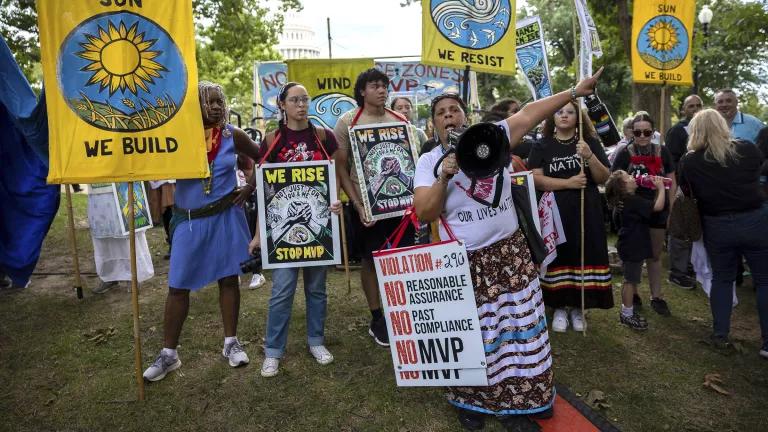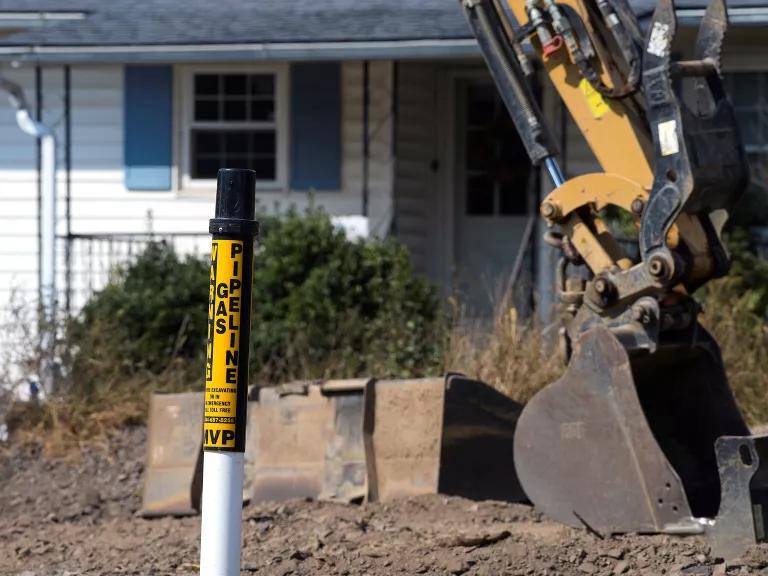Mountain Valley Pipeline Pushed Forward on False Claims of Need
Claims that MVP is needed for energy security or demand—or that it is nearly built and has no legal hurdles ahead—are contradicted by data.

Francis Chung/E&E News/POLITICO via Associated Press
The White House and Speaker of the House Kevin McCarthy have reached an agreement to extend the U.S. debt limit. As NRDC President & CEO Manish Bapna said, parts of the proposed legislation are extreme and “make a mockery of the process of responsible public oversight.”
The debt ceiling agreement wrongfully rubber-stamps the destructive and unnecessary Mountain Valley Pipeline.
Their deal includes legislation that attempts to prevent any courts from reviewing the legality of federal or state agency decisions made to approve the Mountain Valley Pipeline (MVP). This means, for example, that if the U.S. Army Corps of Engineers issues a Clean Water Act permit to allow construction of the pipeline in a sensitive river with endangered species, the courthouse doors might be closed to citizens who want to sue the agency for unlawful actions. As Bapna said, it “cuts local voices out of the process and short-circuits laws put in place to protect the public.” It’s a piece of legislation that offers special benefits for only one corporate entity.
The White House told reporters this was justified because “…the project is nearly done anyway—and has cleared almost all its legal hurdles.” Senator Joe Manchin has also claimed in the past that the pipeline is nearly complete.
Claims that MVP is nearly done, almost built, or has no legal hurdles ahead are false.
The pipeline still has 429 water crossings to be constructed, as well as additional construction that is yet to be completed, as I’ve detailed in past blog posts.

A Mountain Valley Pipeline construction site near a home near Elliston, Virginia.
Charles Mostoller/Reuters
And at least five legal hurdles remain for this pipeline: one federal agency decision is already being challenged; two more recent decisions are anticipated to be challenged; a fourth federal permit is still to be issued; and a state-level permit is still pending. This legal review is essential. Just last week, a federal court found that the Federal Energy Regulatory Commission (FERC) had done an inadequate environmental review of the project’s harms, and needs to take another look.
But now there’s another falsehood circulating about MVP: that it’s needed for national and energy security.
There’s no evidence that MVP is needed for national security or energy security.
Senator Manchin has claimed that the pipeline is needed for national and energy security and, recently, U.S. Secretary of Energy Jennifer Granholm sent a letter to FERC, calling for expeditious action to complete MVP. She claimed that the pipeline can help “enhance the nation’s critical infrastructure for energy and national security,” directly echoing statements by the developers themselves.
Yet, in the eight years since it was formally proposed, there has never been any documented need for MVP. Allowing this pipeline to move forward would accelerate climate change, in addition to the environmental destruction already caused by earlier construction. The project has been stalled because its design doesn’t meet the requirements of our federal environmental laws.
Nevertheless, three agencies in the Biden administration—the U.S. Fish & Wildlife Service, the U.S. Forest Service, and the Bureau of Land Management—recently issued approvals of the pipeline, repeating the errors of the Trump administration’s similar earlier permits, which have been overturned in court. Another permit is pending before the Army Corps of Engineers.
So rather than take the claims that MVP is necessary for national energy security at face value, we decided to investigate to see if the data actually bear them out.
Analysis of gas demand debunks claims of need for MVP; demand for gas will only fall in the future.
The U.S. Energy Information Administration (EIA) is the statistical and analytical agency within the U.S. Department of Energy (DOE). Its role is to collect, analyze, and disseminate independent and impartial energy information. Each year, it publishes energy outlooks for the nation as a whole as well as for regions.
We analyzed publicly available data from EIA’s Annual Energy Outlook 2023, looking at total forecasted gas demand in the two census regions that MVP is expected to supply with gas: the Middle and South Atlantic. EIA models a reference case (representing “business as usual”) plus 14 other scenarios that test the impact of different technological and economic future conditions. We looked across all of these scenarios, searching for any signs of purported enduring natural gas demand from either a near-term (2022 to 2030) or long-term perspective (2022 to 2050).
The results were crystal clear: Natural gas demand is expected to substantially decline in MVP service regions and across the country in the future—not increase.
It’s important to note that EIA’s forecasts tend to be conservative. In addition, these scenarios only include existing, finalized state and federal policies; they don’t include additional clean energy policies that the Biden administration, as well as states and cities, have recently proposed or called for to ensure we meet our climate goals. Fossil fuel demand will decrease even further in any future that makes these climate goals a reality. But even EIA’s "business as usual" forecasts consistently show decreasing demand for gas as the most likely outcome. Of EIA’s 15 scenarios, all but one show a clear decline in overall gas consumption: up to 40 percent less through 2050, even reaching this low by 2030 in certain cases.
The only instance we could find that showed any kind of gas demand growth came from the most pessimistic clean energy scenario—where the costs for clean energy technologies would remain unchanged,instead of decreasing, between 2022 and 2050 (a highly unrealistic assumption; elsewhere, for example, the DOE assumes that the costs of solar will fall 40 percent by 2050 compared to 2022, even in the most conservative case), and the economy would be booming. Even then, the gas demand growth is predicted to be extremely small: +0.5 percent through 2050 for the entire region, driven by a similarly small (+4 percent) amount of growth in the South Atlantic region by 2050.
The trends are crystal clear in this graph:

Figure 1. Historical and future gas demand data from EIA’s Annual Energy Outlook 2023 (projections) and total gas consumption data (historical). Solid colored lines show gas demand in EIA’s best estimate (“Reference case”) scenario based on current laws and regulations in each region from 2022 through 2050. The dots on the right-hand side show the gas demand in 2050 for the reference case (colored diamonds) and all other modeled EIA scenarios (gray dots).
Dawn Woodard, NRDC
And it’s not just EIA projecting a lack of need for new gas supplies.
The North American Electric Reliability Corporation (NERC) is an international regulatory authority that works to ensure the reliability and security of the electrical grid that supplies power to almost 400 million people across the United States, Canada, and part of Mexico. NERC recently released its Summer Reliability Assessment and foresees no resource or reliability problems for East Coast states over the entire 2023 summer peak season. NERC does not call for any increased gas supplies or gas infrastructure to ensure electric reliability. Indeed, it reports that “stored supplies of natural gas…are at high levels.”
As for winter blackouts, recent power outages in Texas and North Carolina were due to freezing cold temperatures that shut down gas wells and caused the failure of mechanical components at gas-fired power plants, augmented by poor planning by utilities—they were not due to inadequate pipeline capacity.
For example, during Winter Storm Elliott in December 2022, 65 percent of gas plant outages in the region managed by PJM (the regional transmission organization that coordinates the movement of wholesale electricity in all or parts of 13 states and the District of Columbia) were due to plant failures. In addition, gas production fell by 20 percent due to the freezing of production wells. Poor utility planning was also a factor. Either power plants were frozen or the wells were frozen—there was never a problem with lack of pipelines.
Gas industry contracting and operations practices have also contributed to power outages, such as gas markets being closed on weekends and holidays, and pipeline owners being able to restrict gas flow on their pipelines and reject changes in the amount or timing of gas that is scheduled to be delivered.
No analysis indicates that pipeline capacity has been a significant factor in fuel supply limitations.
And in case you were wondering, there’s zero indication that MVP would provide gas for export to Europe. European gas demand is also on the decline, with countries looking toward clean and renewable energy to meet long-term energy needs and with already high stored gas supplies this year.
It’s been eight years since MVP was formally proposed. It’s always been a speculative private venture for private gain for a few corporations. Our national security has been fine without it thus far, and that’s not going to change. There’s no place for least valuable player MVP in a true clean energy transition.





